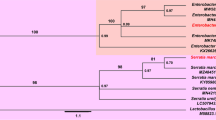Abstract
The thread blight disease of broad leaved trees caused byCylindrobasidium argenteum occurred in laurel forests over 20 yr old after clear cutting in Kyushu. Finding fruit bodies of the causal fungus was possible but very difficult in the forests. In inoculation tests using spores and infected branches harvested in the forests, we succeeded in transmission only with branches. In the forests, the disease is transmitted almost entirely by contact with infected branches. During 1989 to 1992 we found four brown-eared bulbul nests containing branches infected with the disease. In one nest, mycelia of the fungus had been transmitted to the host tree. The occurrence of the disease in forests over 20-yr-old was considered to be due to the nesting of birds in trees which provided the necessary height and closed environment.
Similar content being viewed by others
Literature cited
Engelhard, A. W. and Bragonier, W. H. 1960. Squirrels as possible vectors of the oak wilt fungus in Iowa. Plant Dis. Reptr.44: 192–196.
Heald, F. D. and Studhalter, R. A. 1914. Birds as carriers of the chestnut-blight fungus. Jour. Agr. Res.2: 405–422.
Himelick, E. B., Schein, R. D. and Curl, E. A. 1953. Rodent feeding on mycelial pads of the oak wilt fungus. Plant Dis. Reptr.37: 101–103.
Imazeki, R. 1978. Forest Science (Shinringaku), pp. 210–218. Kyoritushuppan, Tokyo. (In Japanese.)
Imazeki, R. and Aoshima, K. 1955. Fungus decay. In: A memoir of the scientific investigations of the primeval forests in the headwaters of the river ishikari, Hokkaido, Japan, pp. 239–274. Japan Forest Technical Association, Tokyo.
Ito, T. 1951. The white stem blight of trees in Japan. Bull. Tokyo Univ. For.8: 79–87.
Kawabe, Y., Hashimoto, H. and Aoshima, K. 1988. Trunk rot ofCastanopsis cuspidata. Abstracts of papers, 5th Inter. Congr. Plant Pathology, Kyoto, p. 365.
Kobayasi, Y. 1971. On a species causing the thread blight and a so-calledCyphella pulchra in Japan. Trans. Mycol. Soc. Japan12: 70–78.
Kusunoki, M., Kawabe, Y., Ikeda, T. and Kiyohara, T. 1992. Inoculation test ofCorticium argenteum. Bull. Kyushu Branch Jpn Forestry Soc.45: 117–118. (In Japanese.)
Maekawa, N. 1993. Taxonomic study of Japanese Corticiaceae (Aphyllophorales) I. Rept. Tottori Mycol. Inst.31: 1–149.
Manion, P. D. 1981. Tree disease concepts, pp. 208–223. Prentice Hall, New Jersey.
Marx, D. H. and Bryan, W. C. 1975. Growth and ectomycorrhizal development of Loblolly pine seedlings in fumigated soil infested with the fungal symbiontPisolithus tinctorius. Forest Sci.21: 245–254.
Petch, T. B. A. 1923. The diseases of the tea bush, pp. 83–85. Macmillian, London.
Sanui, T. and Kuroki, I. 1995. The thread blight disease occurring on the afforestation treeChamaecyparis obtusa. Forest Pests44, 193–194 (In Japanese.)
Taoda, H. 1984. Regeneration of broad-leaved tree forests dominated byCastanopsis cuspidata with understory trees ofDistylium racemosum. Bull. Kyushu Branch Jpn Forestry Soc.37: 115–116. (In Japanese.).
Taoda, H. 1987. The succession ofCastanopsis cuspidata forest accelerated by the wind damage. In: Plant ecology and taxonomy to the memory of Dr. Satoshi Nakanishi, pp. 379–382. The Kobe Geobotanical Society, Kobe. (In Japanese.)
Taoda, H. 1989. Treatment of evergreen broad-leaved forests dominated byCastanopsis cuspidata in Kyushu. Ringyo Gijutu653: 28–31. (In Japanese.).
Author information
Authors and Affiliations
About this article
Cite this article
Kusunoki, M., Kawabe, Y., Ikeda, T. et al. Role of birds in dissemination of the thread blight disease caused byCylindrobasidium argenteum . Mycoscience 38, 1–5 (1997). https://doi.org/10.1007/BF02464961
Accepted:
Issue Date:
DOI: https://doi.org/10.1007/BF02464961




